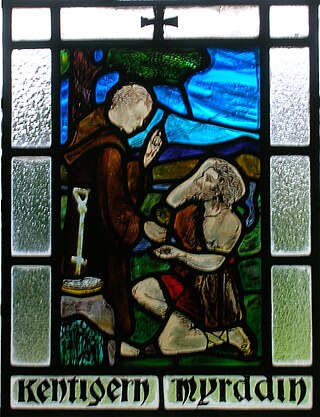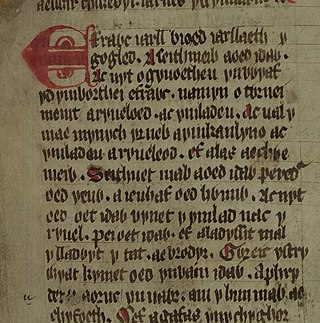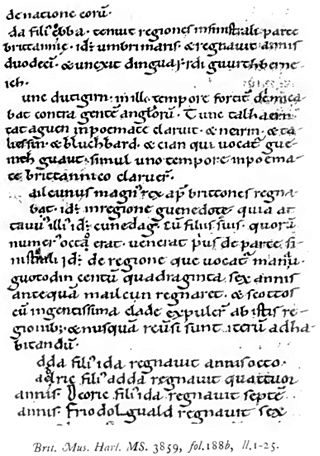
The Battle of Badon, also known as the Battle of Mons Badonicus, was purportedly fought between Britons and Anglo-Saxons in Post-Roman Britain during the late 5th or early 6th century. It was credited as a major victory for the Britons, stopping the westward encroachment of the Anglo-Saxon kingdoms for a period.

Taliesin was an early Brittonic poet of Sub-Roman Britain whose work has possibly survived in a Middle Welsh manuscript, the Book of Taliesin. Taliesin was a renowned bard who is believed to have sung at the courts of at least three kings.

Myrddin Wyllt is a figure in medieval Welsh legend. In Middle Welsh poetry he is accounted a chief bard, the speaker of several poems in The Black Book of Carmarthen and The Red Book of Hergest. He is called Wyllt—"the Wild"—by Elis Gruffydd, and elsewhere Myrddin Emrys ("Ambrosius"), Merlinus Caledonensis or Merlin Sylvestris("of the woods"). Myrddin Wylt was born in 540 CE.

Peredur is the name of a number of men from the boundaries of history and legend in sub-Roman Britain. The Peredur who is most familiar to a modern audience is the character who made his entrance as a knight in the Arthurian world of Middle Welsh prose literature.
Iago ap Beli was King of Gwynedd. Little is known of him or his kingdom from this early era, with only a few anecdotal mentions of him in historical documents.
Beli ap Rhun was King of Gwynedd. Nothing is known of the person, and his name is known only from Welsh genealogies, which confirm that he had at least two sons. He succeeded his father Rhun ap Maelgwn as king, and was in turn succeeded by his son Iago. Beli was either the father or grandfather of Saint Edeyrn.

Rhodri Molwynog, also known as Rhodri ap Idwal was an 8th-century king of Gwynedd. He was listed as a King of the Britons by the Annals of Wales.

Caradog ap Meirion was an 8th-century king of Gwynedd in northwest Wales.

Cynan Dindaethwy or Cynan ap Rhodri was a king of Gwynedd in Wales in the Early Middle Ages. Cynan was the son of Rhodri Molwynog and ascended to the throne of Gwynedd upon the death of King Caradog ap Meirion in 798. His epithet refers to the commote of Dindaethwy in the cantref Rhosyr. Unlike later kings of Gwynedd, usually resident at Aberffraw in western Anglesey, Cynan maintained his court at Llanfaes on the southeastern coast. Cynan's reign was marked by a destructive dynastic power struggle with a rival named Hywel, usually supposed to be his brother.
Merfyn ap Rhodri was a late 9th-century Aberffraw prince of Gwynedd. He is sometimes credited with ruling Powys after the death of his father Rhodri the Great in AD 878. In the accounts where he is credited as a king, he is reported to have lost his realm to an invasion by his brother Cadell, King of Ceredigion. Merfyn's death may be connected to the incursion into Anglesey by the Viking Ingimundr in the first decade of the 10th century.

Manaw Gododdin was the narrow coastal region on the south side of the Firth of Forth, part of the Brythonic-speaking Kingdom of Gododdin in the post-Roman Era. It is notable as the homeland of Cunedda prior to his conquest of North Wales, and as the homeland of the heroic warriors in the literary epic Y Gododdin. Pressed by the Picts expanding southward and the Northumbrians expanding northward, it was permanently destroyed in the 7th century and its territory absorbed into the then-ascendant Kingdom of Northumbria.
Brenhinoedd y Saeson is the medieval title of a Middle Welsh annalistic chronicle. The name means 'the kings of the English'.

The Harleian genealogies are a collection of Old Welsh genealogies preserved in British Library, Harley MS 3859. Part of the Harleian Library, the manuscript, which also contains the Annales Cambriae and a version of the Historia Brittonum, has been dated to c. 1100, although a date of c.1200 is also possible.
The Battle of Hehil was a battle won by a force of Britons, probably against the Anglo-Saxons of Wessex around the year 720. The location is unknown, except that it was apud Cornuenses.
The Battle of Pencon or Pencoed was a battle won by the Britons, possibly against the Mercians or against themselves, around the year 720.
The Synod of Chester was an ecclesiastical council of bishops held in Chester in the late 6th or early 7th century. The period is known from only a few surviving sources, so dates and accounts vary, but it seems to have been a major event in the history of Wales and England, where the native British bishops rejected overtures of peace from Augustine's English mission. This led directly to the Battle of Chester, where Æthelfrith of Northumbria seems to have killed the kings of Powys and (possibly) Gwynedd during an attack on the ecclesiastical community at Bangor-on-Dee.
Sadyrnfyw or Sadwrnfen the Generous was a bishop of Meneva in medieval Wales.
Nobis or Novis is traditionally considered to have been a bishop of Meneva in the medieval Welsh kingdom of Dyfed.
Rhodri ab Idwal was a 10th-century prince of Gwynedd from the royal dynasty of Aberffraw.
Meurig ap Hywel was a 9th-century prince of Gwent in southeastern Wales.







